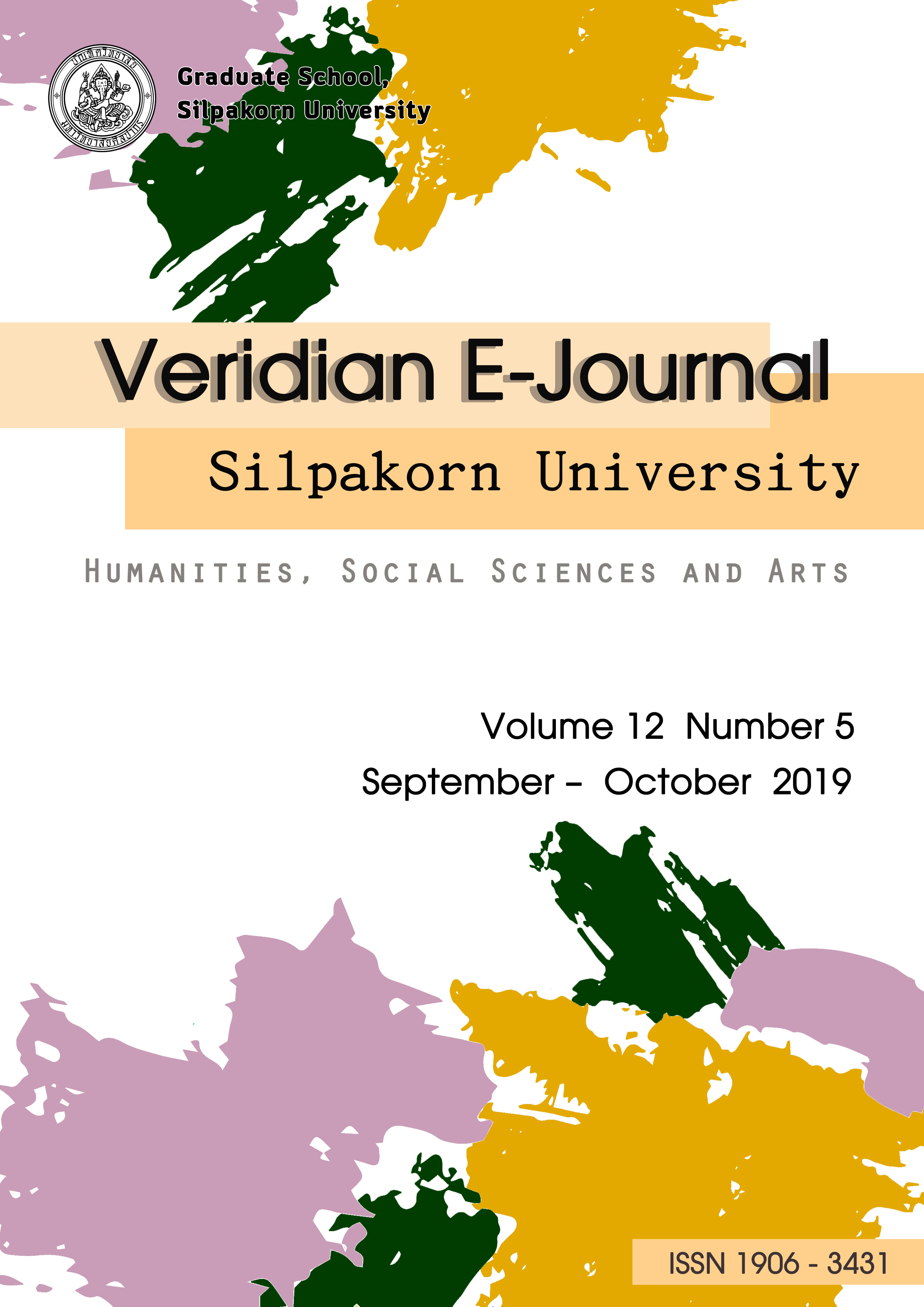เซน : สมาธิกับการสร้างสรรค์ศิลปะ” (Zen : Arts and Meditation”) Arts and Meditation
Main Article Content
Abstract
งานจิตรกรรมจีนและญี่ปุ่นโบราณมักนิยมใช้พลังสมาธิเป็นแนวทางในการสร้างสรรค์ศิลปะกันอย่างแพร่หลาย ดังจะเห็นได้จากผลงานจิตรกรรมจีนในสมัยราชวงศ์ซ่ง อันเป็นยุคสมัยที่ศิลปินนิยมสร้างสรรค์งานด้วยการใช้พู่กันจุ่มหมึก แล้วตวัดลงบนกระดาษอย่างฉับพลันแต่ในขณะเดียวกัน ผลงานบางชิ้นของศิลปินเซนโบราณกลับใช้ความพิถีพิถันในการลงรายละเอียดของงานในบางพื้นที่อย่างประณีตก่อนจะปล่อยฝีพู่กันให้ตวัดไปบนพื้นที่ที่เหลือซึ่งมักจะเป็นพื้นที่ส่วนใหญ่อย่างไม่คำนึงถึงรายละเอียด ดังเช่นผลงานของศิลปินเหลียงไค รูปแบบของการใช้พลังสมาธิในการสร้างสรรค์ผลงานของศิลปินเซนจึงเป็นประเด็นสำคัญที่ผู้ศึกษาสนใจ โดยมีวัตถุประสงค์ทางการศึกษาคือ 1.)เพื่อทำความเข้าใจเกี่ยวกับการใช้พลังสมาธิในการสร้างสรรค์งานของศิลปินในแขนงต่างๆ 2.)เพื่อจำแนกรูปแบบในการใช้พลังสมาธิในการสร้างสรรค์ผลงานของศิลปินเซน และ3.) เพื่อนำแนวทางในการใช้พลังสมาธิในการสร้างสรรค์ผลงานของศิลปินเซนไปประยุกต์ใช้ในการสร้างสรรค์ศิลปะนิพนธ์ชุด “ดุลยภาพ : ร่างกายกับลมหายใจ” (Balance: Body and Mind) ของผู้ศึกษาสำหรับการศึกษาในหลักสูตรดุษฎีบัณฑิต สาขาทัศนศิลป์ โดยศึกษาเปรียบเทียบรูปแบบของพลังสมาธิที่ศิลปินเซนใช้ในการสร้างสรรค์ผลงานในแต่ละประเภท ตั้งแต่อดีตจนถึงปัจจุบัน ซึ่งจากการศึกษาดังกล่าวพบว่า แม้ปัจจุบันผลงานศิลปะเซนร่วมสมัยจะมีวิวัฒนาการ พัฒนาเปลี่ยนแปลงรูปแบบในการสร้างสรรค์ผลงานไปอย่างหลากหลายแนวทางแล้วก็ตาม แต่หากวิเคราะห์แนวความคิดและเนื้อหาวิธีการในการสร้างสรรค์ผลงานของศิลปะเซนแล้วพบว่า หลักแนวความคิด วิธีการในการสร้างสรรค์ผลงานมักมีความเชื่อมโยงกันกับหลักปรัชญาวิถีการดำเนินชีวิตของศิลปินเซนซึ่งเป็นหลักธรรมทางพระพุทธศาสนา
จากการศึกษาพบว่า แนวทางของพลังสมาธิในผลงานสร้างสรรค์ของศิลปินเซนสามารถแบ่งออกได้เป็น 3 รูปแบบคือ 1.) การใช้พลังสมาธิแบบกินระยะเวลาในการสร้างสรรค์ผลงาน 2.) การใช้พลังสมาธิแบบฉับพลันในการสร้างสรรค์ผลงาน และ 3.) การใช้พลังสมาธิทั้งแบบกินระยะเวลาและแบบฉับพลันในการสร้างสรรค์ผลงาน
Ancient Chinese and Japanese paintings are often use meditation power as a guideline to create arts widely. As can be seen from the Chinese painting in the Song Dynasty which was an era in which artists preferred to create works by using the paintbrush dipping in inks and then suddenly flicked on the paper. Meanwhile some of the works of ancient Zen artists have been meticulously created with elaborated details in some areas, before releasing the brush to flick on the rest such as the artworks created by Liang Kai. The patterns of power of meditation utilization in the creating of works by Zen artists are obviously important issues. This research aim are 1.) To understand the use of the power of meditation in order to create works of arts by artists in various fields 2.) To identify patterns in using the power of meditation to encourage the creation of works by Zen artists and 3.) To use the approach of power of meditation to create works of Zen artists in order to apply in the creation of art thesis called “Balance : Body and Mind” which prepared by researcher for the study in the curriculum of Ph.D. in Visual Arts. According to the findings of the study, contemporary Zen arts have nowadays evolved, developed, and transformed in a variety of ways. Zen arts obviously represented that the concepts and methodologies of art creation are often linked to the philosophy of the Zen artists' lifestyles, which are the principles of Buddhism.
According to the study of the arts of Zen found that the guidelines for using the power of meditation in order to create works of Zen artists can be divided into 3 major characteristics, namely 1.) The usage of the power of time consuming meditation to create arts 2.) The usage of the power of sudden meditation to create arts and 3) The usage of both the power of time consuming meditation and sudden meditation to create arts.
